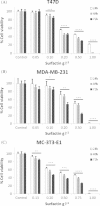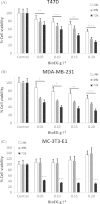Effects of biosurfactants on the viability and proliferation of human breast cancer cells
- PMID: 24949273
- PMCID: PMC4052778
- DOI: 10.1186/s13568-014-0040-0
Effects of biosurfactants on the viability and proliferation of human breast cancer cells
Abstract
Biosurfactants are molecules with surface activity produced by microorganisms that can be used in many biomedical applications. The anti-tumour potential of these molecules is being studied, although results are still scarce and few data are available regarding the mechanisms underlying such activity. In this work, the anti-tumour activity of a surfactin produced by Bacillus subtilis 573 and a glycoprotein (BioEG) produced by Lactobacillus paracasei subsp. paracasei A20 was evaluated. Both biosurfactants were tested against two breast cancer cell lines, T47D and MDA-MB-231, and a non-tumour fibroblast cell line (MC-3 T3-E1), specifically regarding cell viability and proliferation. Surfactin was found to decrease viability of both breast cancer cell lines studied. A 24 h exposure to 0.05 g l(-1) surfactin led to inhibition of cell proliferation as shown by cell cycle arrest at G1 phase. Similarly, exposure of cells to 0.15 g l(-1) BioEG for 48 h decreased cancer cells' viability, without affecting normal fibroblasts. Moreover, BioEG induced the cell cycle arrest at G1 for both breast cancer cell lines. The biosurfactant BioEG was shown to be more active than surfactin against the studied breast cancer cells. The results gathered in this work are very promising regarding the biosurfactants potential for breast cancer treatment and encourage further work with the BioEG glycoprotein.
Keywords: Breast cancer; Cell cycle; Cell viability; Lactobacillus paracasei glycoprotein; Surfactin lipopeptide.
Figures


Similar articles
-
Anticancer Activities of Surfactin and Potential Application of Nanotechnology Assisted Surfactin Delivery.Front Pharmacol. 2017 Oct 26;8:761. doi: 10.3389/fphar.2017.00761. eCollection 2017. Front Pharmacol. 2017. PMID: 29123482 Free PMC article. Review.
-
Production and characterization of surfactin-like biosurfactant produced by novel strain Bacillus nealsonii S2MT and it's potential for oil contaminated soil remediation.Microb Cell Fact. 2020 Jul 20;19(1):145. doi: 10.1186/s12934-020-01402-4. Microb Cell Fact. 2020. PMID: 32690027 Free PMC article.
-
Antimicrobial potential of a lipopeptide biosurfactant derived from a marine Bacillus circulans.J Appl Microbiol. 2008 Jun;104(6):1675-84. doi: 10.1111/j.1365-2672.2007.03701.x. Epub 2008 Jan 9. J Appl Microbiol. 2008. PMID: 18194244
-
Bacillus licheniformis: The unexplored alternative for the anaerobic production of lipopeptide biosurfactants?Biotechnol Adv. 2022 Nov;60:108013. doi: 10.1016/j.biotechadv.2022.108013. Epub 2022 Jun 22. Biotechnol Adv. 2022. PMID: 35752271 Review.
-
Sustainable Production of Biosurfactant from Agro-Industrial Oil Wastes by Bacillus subtilis and Its Potential Application as Antioxidant and ACE Inhibitor.Int J Mol Sci. 2022 Sep 16;23(18):10824. doi: 10.3390/ijms231810824. Int J Mol Sci. 2022. PMID: 36142732 Free PMC article.
Cited by
-
High-throughput optimization of medium components and culture conditions for the efficient production of a lipopeptide pseudofactin by Pseudomonas fluorescens BD5.Microb Cell Fact. 2018 Aug 4;17(1):121. doi: 10.1186/s12934-018-0968-x. Microb Cell Fact. 2018. PMID: 30077177 Free PMC article.
-
Production of Mannosylerythritol Lipids (MELs) to be Used as Antimicrobial Agents Against S. aureus ATCC 6538.Curr Microbiol. 2020 Aug;77(8):1373-1380. doi: 10.1007/s00284-020-01927-2. Epub 2020 Mar 2. Curr Microbiol. 2020. PMID: 32123984 Free PMC article.
-
Direct quantification of lipopeptide biosurfactants in biological samples via HPLC and UPLC-MS requires sample modification with an organic solvent.Appl Microbiol Biotechnol. 2017 Jun;101(11):4747-4759. doi: 10.1007/s00253-017-8272-y. Epub 2017 Apr 22. Appl Microbiol Biotechnol. 2017. PMID: 28432441 Free PMC article.
-
Anticancer Activities of Surfactin and Potential Application of Nanotechnology Assisted Surfactin Delivery.Front Pharmacol. 2017 Oct 26;8:761. doi: 10.3389/fphar.2017.00761. eCollection 2017. Front Pharmacol. 2017. PMID: 29123482 Free PMC article. Review.
-
Bacterial Therapy of Cancer: A Way to the Dustbin of History or to the Medicine of the Future?Int J Mol Sci. 2023 Jun 3;24(11):9726. doi: 10.3390/ijms24119726. Int J Mol Sci. 2023. PMID: 37298677 Free PMC article. Review.
References
-
- Brzozowski B, Bednarski W, Golek P. The adhesive capability of two Lactobacillus strains and physicochemical properties of their synthesized biosurfactants. Food Technol Biotechnol. 2011;4:177–186.
-
- Burgos-Díaz C, Martín-Venegas R, Martínez V, Storniolo CE, Teruel JA, Aranda FJ, Ortiz A, Manresa A, Ferrer R, Marqués AM. In vitro study of the cytotoxicity and antiproliferative effects of surfactants produced by Sphingobacterium detergens. Int J Pharma. 2013;4:433–440. doi: 10.1016/j.ijpharm.2013.06.029. - DOI - PubMed
LinkOut - more resources
Full Text Sources
Other Literature Sources
Miscellaneous

